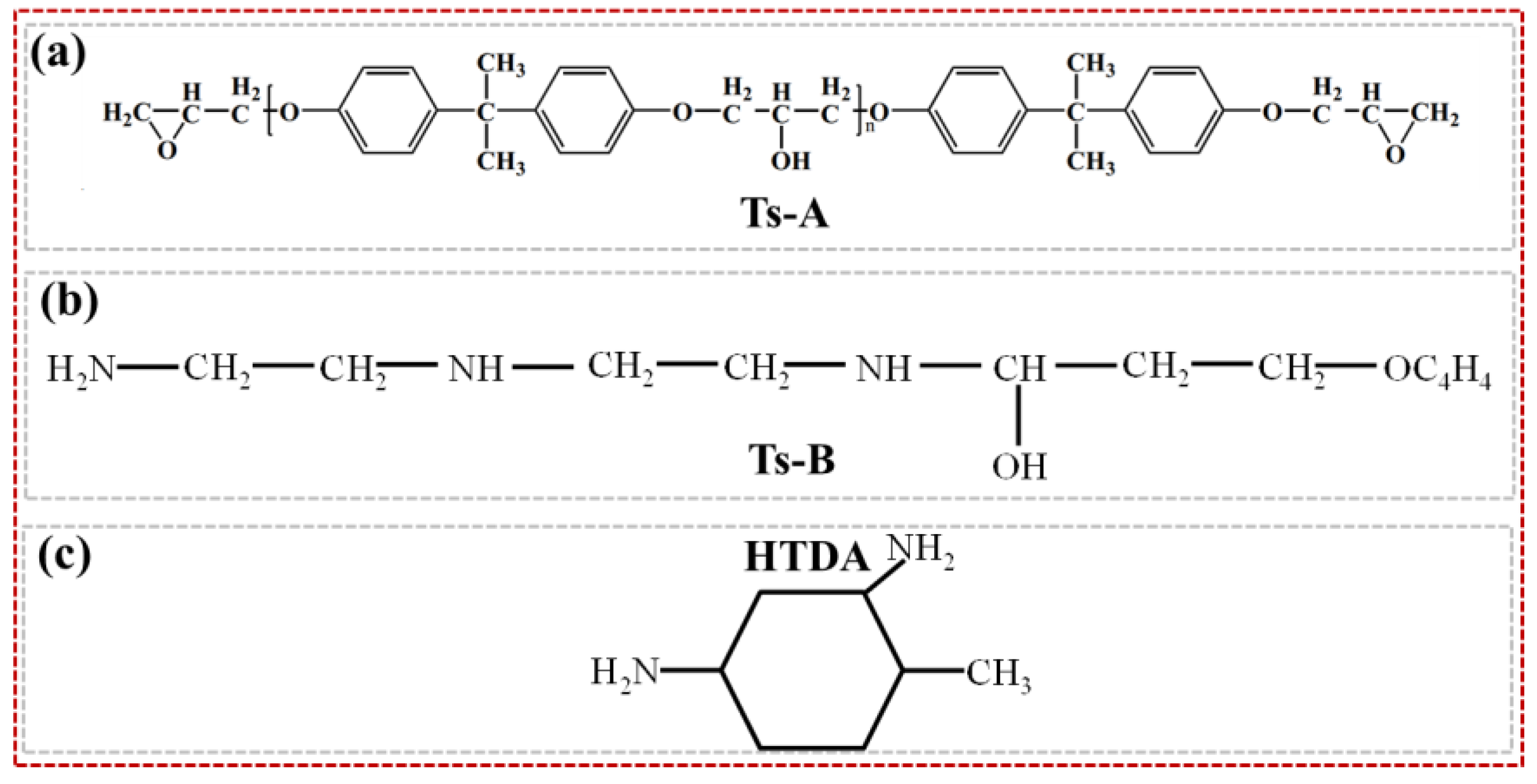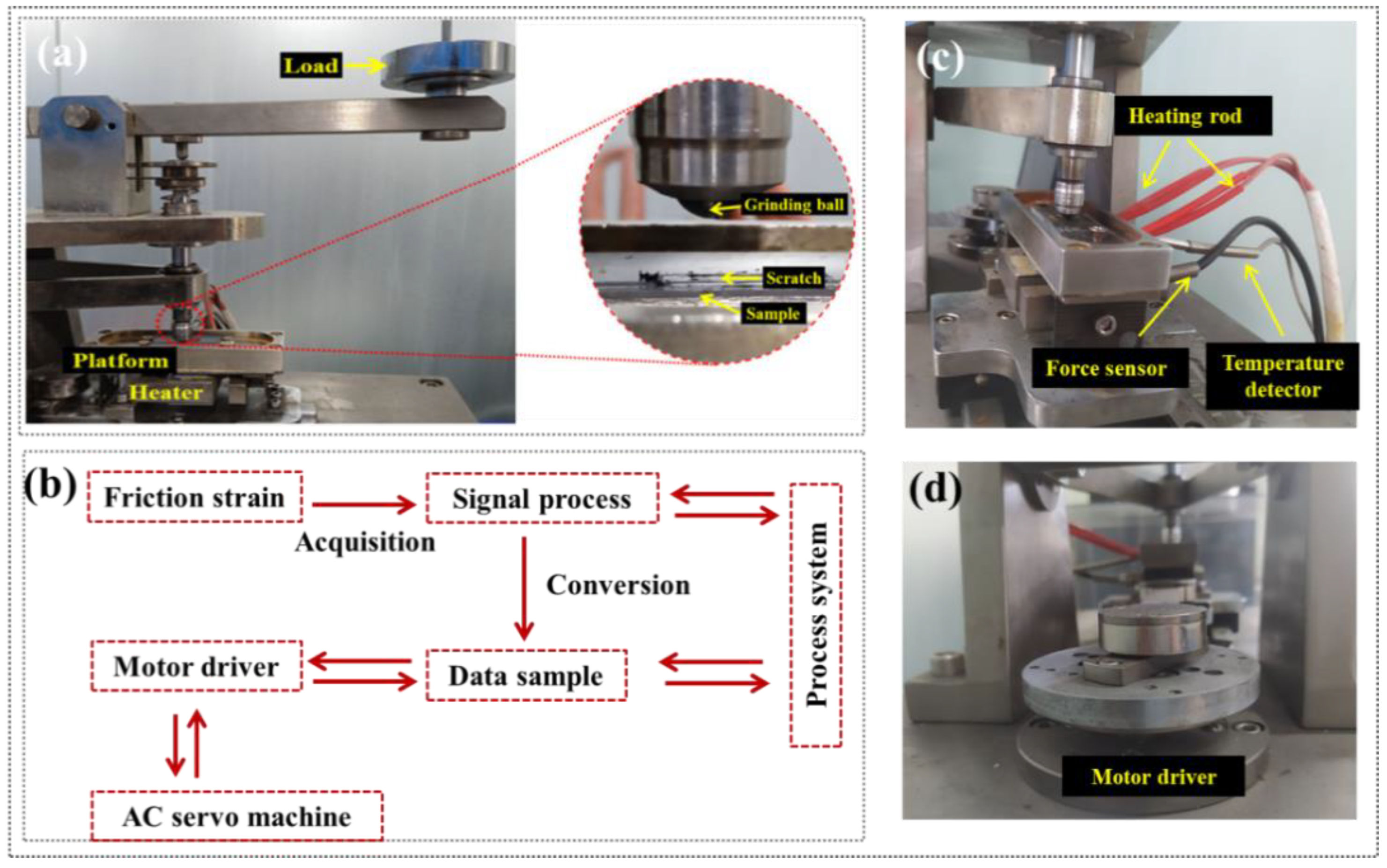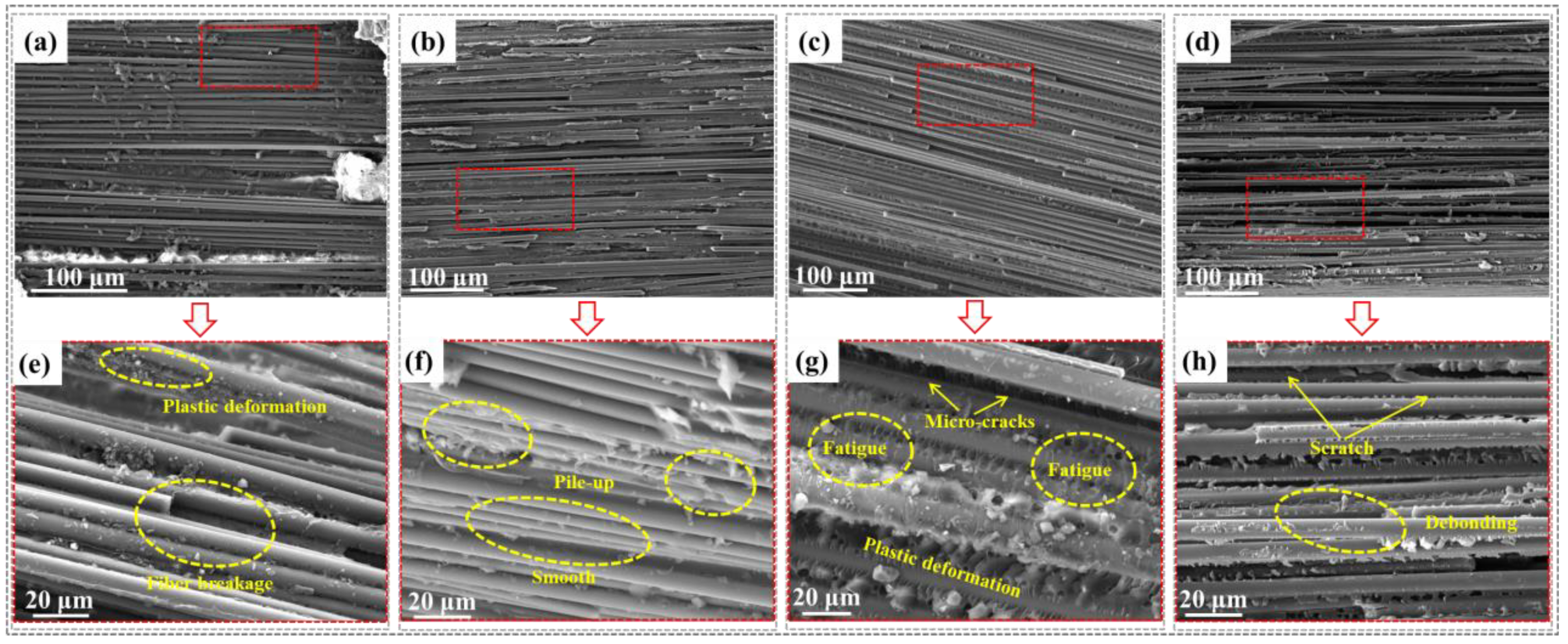Friction Behaviors and Wear Mechanisms of Carbon Fiber Reinforced Composites for Bridge Cable
Abstract
:1. Introduction
2. Materials and Methods
2.1. Raw Materials and Sample Preparation
2.2. Friction and Wear Testing
2.3. Morphology Analysis
3. Results and Discussion
3.1. Friction Behaviors
3.1.1. Effect of Applied Loads
3.1.2. Effect of Sliding Speeds
3.1.3. Effect of Service Temperatures
3.1.4. Effect of Water Lubrication
3.2. Wear Mechanism Analysis
4. Conclusions
- (1)
- The friction and wear performance of CFRP exhibited the greatest sensitivity to the applied load, as the tangential displacement generated considerable shear stress at the interface between the sample and the grinding ball. Service temperature emerged as the second most critical factor influencing these properties, while water lubrication ranked last due to its effective lubricating properties and heat dissipation capabilities.
- (2)
- Compared to 500 g, the Ws and WSW of CFRP under a 2000 g load increased by 158% and 113%, respectively. This was due to the large tangential displacement along the sliding direction, causing debonding damage at the fiber/resin interface and reducing the strength and stiffness of CFRP against external loads. The wear mechanism was delamination wear.
- (3)
- Compared to room temperature, the wear rate of CFRP at service temperatures of 100 °C and 120 °C increased by 75% and 112%, respectively. This was because the elevated temperature conditions made the glassy resin into a high elastic state, resulting in the continuous initiation and expansion of CFRP surface cracks, eventually generating tearing and surface fatigue phenomena, consistent with the fatigue wear mechanism.
- (4)
- The sliding speed and water lubrication had an insignificant effect on the COFs of CFRP (less than 20%), especially under 60 °C water lubrication, where the COFs fluctuated by only 15%. This was because the lubricating and cooling functions of water molecules alleviated the friction state in the friction interface, causing only slight abrasive wear. The wear rate of CFRP at 120 mm/s sliding speed increased by 74% compared to 60 mm/s, due to the large speed differential causing uncoordinated deformation, triggering the adhesive wear mechanism.
Author Contributions
Funding
Institutional Review Board Statement
Data Availability Statement
Conflicts of Interest
References
- Tian, J.W.; Li, C.G.; Xian, G.J. A layered superhydrophobic coating with excellent mechanical robustness and anti-corrosion performances. J. Mater. Res. Technol. 2022, 21, 4281–4298. [Google Scholar] [CrossRef]
- Ke, L.; Li, Y.; Li, C.; Cheng, Z.; Ma, K.; Zeng, J. Bond behavior of CFRP-strengthened steel structures and its environmental influence factors: A critical review. Sustain. Struct. 2024, 4, 000038. [Google Scholar] [CrossRef]
- Qi, X.; Tian, J.W.; Guo, R.; Xian, G.J. Hydrothermal aging of carbon fiber reinforced polymer rods intended for cable applications in civil engineering. J. Mater. Res. Technol. 2023, 26, 5151–5166. [Google Scholar] [CrossRef]
- Bai, J. Advanced Fibre-Reinforced Polymer (FRP) Composites for Structural Applications; Woodhead Publishing: Cambridge, UK, 2022. [Google Scholar]
- Sun, Z.; Luo, Y.; Chen, C.; Dong, Z.; Jiang, G.; Chen, F.; Ma, P. Mechanical enhancement of carbon fiber-reinforced polymers: From interfacial regulating strategies to advanced processing technologies. Prog. Mater. Sci. 2023, 142, 101221–101246. [Google Scholar] [CrossRef]
- Qi, X.; Tian, J.; Xian, G. Hydrothermal ageing of carbon fiber reinforced polymer composites applied for construction: A review. J. Mater. Res. Technol. 2023, 27, 1017–1045. [Google Scholar] [CrossRef]
- Tian, J.W.; Qi, X.; Li, C.G.; Xian, G.J. Mussel-Inspired Fabrication of an Environment-Friendly and Self-Adhesive Superhydrophobic Polydopamine Coating with Excellent Mechanical Durability, Anti-Icing and Self-Cleaning Performances. ACS Appl. Mater. Interfaces 2023, 15, 26000–26015. [Google Scholar] [CrossRef]
- Liang, R.; Hota, G. Development and evaluation of load-bearing fiber reinforced polymer composite panel systems with tongue and groove joints. Sustain. Struct. 2021, 1, 000008. [Google Scholar] [CrossRef]
- Xia, Z.; Jiang, T.; Yu, T. Innovating arch structures with fiber-reinforced polymer composites: A review. Adv. Struct. Eng. 2023, 26, 2341–2358. [Google Scholar] [CrossRef]
- Lobanov, D.; Slovikov, S.; Lunegova, E. Influence of Internal Technological Defects on the Mechanical Properties of Structural CFRP. Frat. Integrità Strutt. 2023, 17, 74–87. [Google Scholar] [CrossRef]
- Sethi, S.; Ray, B.C. Environmental effects on fibre reinforced polymeric composites: Evolving reasons and remarks on interfacial strength and stability. Adv. Colloid Interface Sci. 2015, 217, 43–67. [Google Scholar] [CrossRef]
- Wang, A.; Liu, X.; Yue, Q. Research progress of carbon fiber reinforced polymer composite cable: Anchorage system and service performance. J. Build. Struct. 2022, 43, 45–54. [Google Scholar]
- Niu, Y.-F.; Yan, Y.; Yao, J.-W. Hygrothermal aging mechanism of carbon fiber/epoxy resin composites based on quantitative characterization of interface structure. Polym. Test. 2021, 94, 107019. [Google Scholar] [CrossRef]
- Xian, G.; Zhou, P.; Bai, Y.; Wang, J.; Li, C.; Dong, S.; Guo, R.; Li, J.; Du, H.; Zhong, J. Design, preparation and mechanical properties of novel glass fiber reinforced polypropylene bending bars. Constr. Build. Mater. 2024, 429, 136455. [Google Scholar] [CrossRef]
- Sahu, R.; Ponnusami, S.A.; Weimer, C.; Harursampath, D. Interface engineering of carbon fiber composites using CNT: A review. Polym. Compos. 2024, 45, 9–42. [Google Scholar] [CrossRef]
- Zhuang, X.; Ma, J.; Dan, Y.; Jiang, L.; Huang, Y. Hydrothermal aging of carbon fiber reinforced epoxy composites with different interface structures. Polym. Degrad. Stab. 2023, 212, 110352. [Google Scholar] [CrossRef]
- Xian, G.; Bai, Y.; Zhou, P.; Wang, J.; Li, C.; Dong, S.; Guo, R.; Tian, J.; Li, J.; Zhong, J. Long-term properties evolution and life prediction of glass fiber reinforced thermoplastic bending bars exposed in concrete alkaline environment. J. Build. Eng. 2024, 91, 109641. [Google Scholar] [CrossRef]
- Yong, D.; Yu, M.; Wenbo, S.; Zhenhai, W. Effect of hygrothermal aging on moisture diffusion and tensile behavior of CFRP composite laminates. Chin. J. Aeronaut. 2023, 36, 382–392. [Google Scholar]
- Tian, J.; Qi, X.; Li, C.; Xian, G. Friction behaviors and wear mechanisms of multi-filler reinforced epoxy composites under dry and wet conditions: Effects of loads, sliding speeds, temperatures, water lubrication. Tribol. Int. 2023, 179, 108148. [Google Scholar] [CrossRef]
- Tian, J.; Tang, Q.; Li, C.; Xian, G. Mechanical, bonding and tribological performances of epoxy-based nanocomposite coatings with multiple fillers. J. Appl. Polym. Sci. 2022, 139, 52303. [Google Scholar] [CrossRef]
- Tian, J.; Li, C.; Xian, G. Reciprocating friction and wear performances of nanometer sized-TiO2 filled epoxy composites. Polym. Compos. 2021, 42, 2061–2072. [Google Scholar] [CrossRef]
- Yadav, R.; Singh, M.; Shekhawat, D.; Lee, S.-Y.; Park, S.-J. The role of fillers to enhance the mechanical, thermal, and wear characteristics of polymer composite materials: A review. Compos. Part A Appl. Sci. Manuf. 2023, 175, 107775–107787. [Google Scholar] [CrossRef]
- Cao, J.; Luo, Y. Study on tribological properties of epoxy resin composites. J. Phys. Conf. Ser. 2022, 2256, 012014. [Google Scholar] [CrossRef]
- Hu, J.; Zhang, K.; Yang, Q.; Cheng, H.; Liu, S.; Yang, Y. Fretting behaviors of interface between CFRP and coated titanium alloy in composite interference-fit joints under service condition. Mater. Des. 2017, 134, 91–102. [Google Scholar] [CrossRef]
- Xian, G.; Zhou, P.; Li, C.; Dong, S.; Du, H.; Tian, J.; Guo, R.; Peng, Z.; Zhang, Z.; He, T. Mechanical properties evaluation of glass fiber reinforced thermoplastic composite plate under combined bending loading and water immersion. Constr. Build. Mater. 2024, 440, 137470. [Google Scholar] [CrossRef]
- Fusaro, R.L. Self-lubricating polymer composites and polymer transfer film lubrication for space applications. Tribol. Int. 1990, 23, 105–122. [Google Scholar] [CrossRef]
- Du, Y.; Zhang, Z.; Wang, D.; Zhang, L.; Cui, J.; Chen, Y.; Wu, M.; Kang, R.; Lu, Y.; Yu, J. Enhanced tribological properties of aligned graphene-epoxy composites. Friction 2022, 10, 854–865. [Google Scholar] [CrossRef]
- Tian, J.W.; Li, C.G.; Qi, X.; Xian, G.J. Hygrothermal aging behavior and mechanism of multi-filler reinforced epoxy composites for steel structure coatings. Eur. Polym. J. 2023, 184, 111780. [Google Scholar] [CrossRef]
- Zhang, X.; Zhang, M.; Shao, M.; Geng, X.; Sun, Y.; Niu, M.; Miao, Y.; Wang, X. Comparative Study on Tribological Behavior of Fe3Al Alloy Against Different Counterparts in Seawater. J. Mater. Eng. Perform. 2021, 30, 8030–8039. [Google Scholar] [CrossRef]
- Dasari, A.; Yu, Z.-Z.; Mai, Y.-W. Fundamental aspects and recent progress on wear/scratch damage in polymer nanocomposites. Mater. Sci. Eng. R Rep. 2009, 63, 31–80. [Google Scholar] [CrossRef]
- Tian, J.; Bai, Y.; Li, C. Enhancement mechanism of nylon 6 filler on the mechanical and frictional wear properties of carbon fiber-epoxy resin composites. Acta Mater. Compos. Sin. 2023, 40, 5011–5025. [Google Scholar]
- Tian, J.W.; Qi, X.; Xian, G.J. Effect of hygrothermal aging on the friction behavior and wear mechanism of the multi-filler reinforced epoxy composites for coated steel. J. Mater. Res. Technol. 2024, 32, 140–151. [Google Scholar] [CrossRef]
- Abdulla, F.A.; Hamid, K.L.; Ogaili, A.A.F.; Abdulrazzaq, M.A. Experimental study of Wear Rate Behavior for Composite Materials under Hygrothermal Effect. IOP Conf. Ser. Mater. Sci. Eng. 2020, 928, 022009–022019. [Google Scholar] [CrossRef]
- Xian, G.; Bai, Y.; Qi, X.; Wang, J.; Tian, J.; Xiao, H. Hygrothermal aging on the mechanical property and degradation mechanism of carbon fiber reinforced epoxy composites modified by nylon 6. J. Mater. Res. Technol. 2024, 33, 6297–6306. [Google Scholar] [CrossRef]
- Bandaru, A.K.; Weaver, P.M.; O’Higgins, R.M. Abrasive wear performance of hygrothermally aged glass/PTFE composites. Polym. Test. 2021, 103, 107369–107379. [Google Scholar] [CrossRef]
- Bachchan, A.A.; Das, P.P.; Chaudhary, V. Effect of moisture absorption on the properties of natural fiber reinforced polymer composites: A review. Mater. Today Proc. 2022, 49, 3403–3408. [Google Scholar] [CrossRef]








| Applied Load (g) | COFs | Ws (10−6 mm3/(N·m)) | WSW (μm) | Maximum Wear Depth (μm) |
|---|---|---|---|---|
| 500 | 0.04–0.12 | 15.2 (±2.2) | 626.3 (±48.1) | 8.7 (±1.4) |
| 1000 | 0.05–0.10 | 26.7 (±1.9) | 1012.5 (±39.6) | 11.5 (±0.9) |
| 1500 | 0.03–0.09 | 33.1 (±3.4) | 1125.6 (±54.1) | 13.3 (±1.2) |
| 2000 | 0.03–0.07 | 38.9 (±2.4) | 1321.8 (±44.2) | 15.9 (±0.8) |
| Sliding Rate (mm/s) | COFs | Ws (10−6 mm3/(N·m)) | WSW (μm) | Maximum Wear Depth (μm) |
|---|---|---|---|---|
| 60 | 0.04–0.07 | 13.6 (±1.3) | 659.2 (±21.3) | 9.5 (±0.9) |
| 80 | 0.04–0.05 | 18.2 (±2.0) | 792.1 (±40.3) | 10.1 (±1.3) |
| 100 | 0.03–0.06 | 20.4 (±1.4) | 864.3 (±36.0) | 10.4 (±0.4) |
| 120 | 0.05–0.09 | 24.2 (±1.7) | 1037.5 (±38.4) | 11.0 (±0.5) |
| Serviced Temperature (°C) | COFs | Ws (10−6 mm3/(N·m)) | WSW (μm) | Maximum Wear Depth (μm) |
|---|---|---|---|---|
| R.T. | 0.06–0.09 | 14.2 (±1.4) | 757.4 (±52.4) | 10.8 (±0.9) |
| 60 | 0.05–0.08 | 16.3 (±1.8) | 781.6 (±46.9) | 11.2 (±0.6) |
| 80 | 0.05–0.08 | 21.2 (±3.6) | 842.4 (±44.1) | 11.5 (±1.2) |
| 100 | 0.05–0.07 | 24.5 (±2.7) | 931.6 (±39.2) | 12.0 (±1.1) |
| 120 | 0.04–0.06 | 29.7 (±2.0) | 1127.3 (±35.6) | 12.4 (±1.6) |
| Water Lubrication (°C) | COFs | Ws (10−6 mm3/(N·m)) | WSW (μm) | Maximum Wear Depth (μm) |
|---|---|---|---|---|
| R.T. | 0.04−0.06 | 6.1 (±0.9) | 554.2 (±19.8) | 7.9 (±0.9) |
| 60 | ~0.06 | 10.3 (±1.1) | 595.8 (±32.7) | 8.4 (±1.3) |
| 80 | 0.05−0.07 | 14.8 (±1.2) | 689.5 (±29.4) | 8.7 (±0.4) |
| 95 | 0.04−0.08 | 16.2 (±2.1) | 773.6 (±43.5) | 9. 2 (±0.8) |
Disclaimer/Publisher’s Note: The statements, opinions and data contained in all publications are solely those of the individual author(s) and contributor(s) and not of MDPI and/or the editor(s). MDPI and/or the editor(s) disclaim responsibility for any injury to people or property resulting from any ideas, methods, instructions or products referred to in the content. |
© 2024 by the authors. Licensee MDPI, Basel, Switzerland. This article is an open access article distributed under the terms and conditions of the Creative Commons Attribution (CC BY) license (https://creativecommons.org/licenses/by/4.0/).
Share and Cite
Xian, G.; Qi, X.; Guo, R.; Tian, J.; Xiao, H.; Li, C. Friction Behaviors and Wear Mechanisms of Carbon Fiber Reinforced Composites for Bridge Cable. Polymers 2024, 16, 3446. https://doi.org/10.3390/polym16233446
Xian G, Qi X, Guo R, Tian J, Xiao H, Li C. Friction Behaviors and Wear Mechanisms of Carbon Fiber Reinforced Composites for Bridge Cable. Polymers. 2024; 16(23):3446. https://doi.org/10.3390/polym16233446
Chicago/Turabian StyleXian, Guijun, Xiao Qi, Rui Guo, Jingwei Tian, Huigang Xiao, and Chenggao Li. 2024. "Friction Behaviors and Wear Mechanisms of Carbon Fiber Reinforced Composites for Bridge Cable" Polymers 16, no. 23: 3446. https://doi.org/10.3390/polym16233446
APA StyleXian, G., Qi, X., Guo, R., Tian, J., Xiao, H., & Li, C. (2024). Friction Behaviors and Wear Mechanisms of Carbon Fiber Reinforced Composites for Bridge Cable. Polymers, 16(23), 3446. https://doi.org/10.3390/polym16233446






